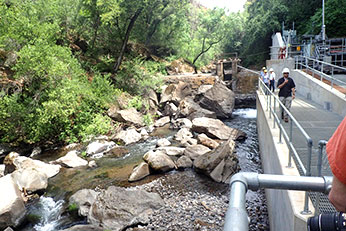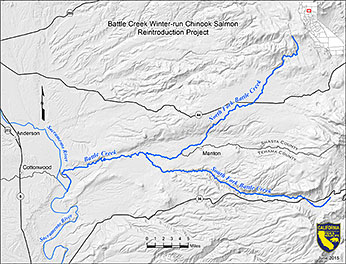(Battle Creek, Tehama Counties)
2016 Status Update
The Battle Creek winter-run Chinook Salmon Reintroduction Plan (Plan) (PDF) is complete and provides an excellent strategy to reintroduce winter-run Chinook Salmon into Battle Creek.
The Plan is important for several reasons:
- aids in winter-run Chinook Salmon recovery,
- eases some drought-related stresses on winter-run Chinook Salmon, and
- provides a template for other reintroduction plans.
The Plan describes issues, considerations, and steps necessary to re-establish winter-run Chinook Salmon in North Fork Battle Creek. Considerations taken into account include fish sources for the reintroduction, fish transfer and release strategies, and hatchery needs. Winter-run Chinook Salmon reintroduced into Battle Creek will require an intensive marking strategy, including genetic testing, monitoring using Passive Integrated Transponder (PIT) and coded-wire tags, and secondary external marks. The Plan also includes tactics for recolonization, local adaptation, and the long-term management of the reintroduced stocks. As part of this effort, the Plan includes an extensive monitoring and evaluation approach. Implementation of this Plan is contingent on several factors such as: successful hatchery production, restored capacity at Battle Creek, and the abundance of natural returns. Reintroduction is a long-term process.
Ultimately, this Plan seeks to produce a self-sustaining, locally-adapted winter-run Chinook Salmon population in North Fork Battle Creek.
When implemented, this Plan will contribute to the recovery of California’s endangered winter-run Chinook Salmon. Protecting the existing population and expanding its range into areas with quality spawning and rearing habitat provides this high-risk population with resilience to changing environments.
Species / Location
 Battle Creek Reintroduction. Photo by HMcIntire.
Battle Creek Reintroduction. Photo by HMcIntire.
 Battle Creek Chinook Reintroduction Map (click/tap to enlarge)
Battle Creek Chinook Reintroduction Map (click/tap to enlarge)
Historically, Battle Creek supported all four runs of Chinook salmon: fall-run, late fall-run, spring-run and winter-run. Battle Creek’s cool water springs allowed for this diversity to develop. Today, hydroelectric facilities and human actions have led to habitat losses and declines in the abundance of all four runs. Winter-run Chinook salmon are no longer present in the Battle Creek watershed.
Battle Creek is an east-side tributary to the Sacramento River located about 5 miles southeast of the Shasta County town of Cottonwood.
Viable populations of winter-run Chinook salmon require high-quality habitat with cool, clean water. Battle Creek restoration is creating that needed spawning and rearing habitat. U.S. Bureau of Reclamation (USBR) leads the Battle Creek Salmon and Steelhead Restoration Project (Restoration Project). The goal of the Restoration Project is to reestablish approximately 42 miles of prime salmon and steelhead habitat on Battle Creek, plus an additional six miles on its tributaries. In addition to habitat restoration, associated projects include dam removal, retrofitting remaining dams with fish ladders and screens and reintroduction of winter-run Chinook salmon. This project creates the plan for reintroduction of winter-run Chinook salmon to Battle Creek.
Need for Program
The urgency of the Restoration Project is heightened by the fact that winter-run are on the brink of extinction and California is currently experiencing critical multi-year drought. Under the Endangered Species Act (ESA), the Sacramento River winter-run Chinook salmon (Oncorhynchus tshawytscha) evolutionarily significant unit (ESU) has been federally listed as endangered since 1989. The ESU is composed of only a single population, which spawn predominantly in a 5-mile stretch of the Sacramento River downstream of Shasta and Keswick dams. As it currently exists, the existing population of winter-run is considered to be perilously susceptible to the effects of multi-year droughts, which deplete the storage of cold water that is necessary for winter-run to successfully reproduce.
Successfully reintroducing and maintaining a viable population of winter-run into Battle Creek will be arguably the most significant step towards winter-run recovery that has been taken since the species was listed 25 years ago. Monitoring data suggests winter-run do not stray into Battle Creek in appreciable numbers and are therefore unlikely to re-establish a self-sustaining population without human intervention. Active reintroduction is necessary for a winter-run Chinook population to be re-established. The Implementation Plan for reintroducing winter-run Chinook salmon to Battle Creek will provide detailed plans on the process of this reintroduction.
Future Efforts
Completion of the winter-run Chinook Salmon Reintroduction Plan will enable the CDFW and its partners to begin placing winter-run Chinook salmon into Battle Creek. Successful reintroductions and maintaining a viable, self-sustaining population will be a significant step toward winter-run Chinook salmon recovery.
Partners
The Battle Creek Restoration Project is a collaboration between several partners.
- United States Bureau of Reclamation
- United States Fish and Wildlife Service
- National Marine Fisheries Service
- California Department of Fish and Wildlife
- Pacific Gas and Electric
- Battle Creek Watershed Conservancy